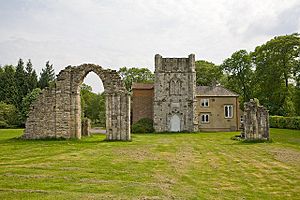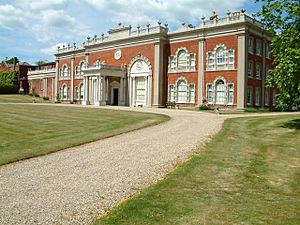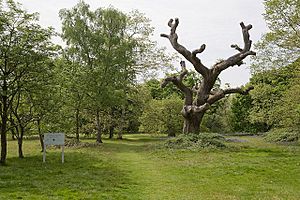Cranbury Park facts for kids
Cranbury Park is a beautiful old country house and large estate. It is located in Hursley, a village near Winchester, England. This historic place was once home to the famous scientist Sir Isaac Newton. Later, the Chamberlayne family owned it, and their descendants still live there today. Cranbury Park is usually a private home, but sometimes it opens its doors for special events.
Contents
History of Cranbury Park
Early Times at Cranbury
Long ago, Cranbury was a small village with many farms. Over time, the name came to mean just Cranbury House and its park. One of the first people known to live there was Mr. Shoveller, who gave the property to Roger Coram before 1580. Coram rented Cranbury from Sir Thomas Clarke, who was the Lord of the Manor.
There's an interesting story about a disagreement between Roger Coram and Sir Thomas Clarke. It was about the rights of the workers who helped on the lord's land. These workers were supposed to get food while they worked. One day, the food they were given was very bad. The workers refused to work, and Mr. Coram supported them. This strong stand helped make sure workers were treated fairly.
After Coram, Sir Edward Richards owned the property. He later rented it to Dr. John Young, who was a dean in Winchester. Dr. Young lived quietly at Cranbury during a time of political change in England. His widow later passed the house to Sir Charles Wyndham, who married her daughter in 1665. Sir Charles was known for standing up for the rights of tenants, just like Coram. He was also a Member of Parliament for many years.
Sir Isaac Newton's Connection
When Lady Wyndham passed away, John Conduitt bought Cranbury Park. In 1721, Conduitt married Catherine Barton, who was the half-niece and adopted daughter of Sir Isaac Newton. Soon after his marriage, Conduitt became a Member of Parliament.
Towards the end of his life, Sir Isaac Newton lived at Cranbury Park. He stayed there until he died in 1727. After Newton's death, John Conduitt took over his important job as Master of the Mint, which was in charge of making coins.
Sir Isaac Newton helped design a special sundial for the gardens at Cranbury Park. This sundial was very detailed. It showed minutes, hours, and even told you if your watch was fast or slow. It also listed names of places around the world where it would be noon at the same time. The sundial had Mr. Conduitt's initials and his family motto, which means "Each one is the son of his deeds."
The Dummers and a Park "Castle"
After Conduitt died in 1737, his daughter's guardians sold Cranbury Park to Thomas Lee Dummer. He also became a Member of Parliament. When he died, his son, also named Thomas Dummer, inherited the estate. This second Thomas Dummer was also an MP for several different areas.

In 1770, Thomas Dummer tried to buy an old city cross from Winchester to move it to Cranbury. But when his workers arrived, the people of Winchester protested and stopped them! So, Dummer had to give up on that idea. Instead, he built a fake cross out of wood and plaster, but it fell apart after about sixty years.
Not giving up, Dummer then turned his attention to Netley Abbey, which he also owned. He moved parts of the abbey's ruins to Cranbury Park. Today, you can still see these ruins in the park. They look like a small castle and are even called "the Castle" by local villagers. The back of this "castle" was made into a small cottage.
Thomas Dummer died in 1781 without children. He left his property to his widow, Harriet. She later married the artist Nathaniel Dance, who became Sir Nathaniel Dance-Holland. His brother, George Dance, actually designed the main house we see today, which was built in 1780. Sir Nathaniel was also a Member of Parliament.
The Chamberlayne Family Takes Over
Sir Nathaniel Dance-Holland died in 1811, and his wife passed away in 1825. After her death, William Chamberlayne inherited Cranbury Park. William Chamberlayne was a Member of Parliament for Southampton. He was also involved in bringing gas lighting to Southampton and donated columns for new streetlights.
When William Chamberlayne died in 1829, the estate went to his cousin, Thomas Chamberlayne. This Thomas (1805–1876) was a very keen yachtsman. He sailed his yacht, Arrow, in the very first America's Cup race in 1851. The Arrow even beat the famous American yacht, America, in another race in 1852! Thomas also played cricket and loved hunting. He built new stables and a cricket pitch at Cranbury Park.
After Thomas died in 1876, his son, Tankerville Chamberlayne, took over the estate. Tankerville was also a Member of Parliament for Southampton. He later moved to live permanently at Cranbury Park.
Tankerville Chamberlayne died in 1924, and his son, also named Tankerville Chamberlayne, inherited the estate. He was then succeeded by his daughter, Penelope Mary Alexandra Chamberlayne, in 1943. She married Major Nigel Donald Peter Macdonald, and they combined their last names to "Chamberlayne-Macdonald." The family still lives at Cranbury Park today.
During the Second World War, Cranbury House was used by Canadian troops. They stayed there briefly before heading off for the Normandy landings in France.
The House at Cranbury Park
The Cranbury Park house you see today was built in 1780. It was designed by George Dance the Younger for Thomas Dummer and his wife. The house is made of red brick with stone details.
The main entrance has a special covered porch where carriages could drive through. On either side of this porch are large windows with columns. The house has many windows with a "Venetian window" style, which means they have three parts. These were added later by Thomas Chamberlayne in the 1830s. There are also decorative railings with urns around the top of the house, which make it look very grand.
Inside, the house is very impressive. One writer called the main hall an "unforgettable experience" because of its high, arched ceilings. The ballroom has a beautiful circular domed ceiling. Many rooms have lovely plaster decorations. The library was designed around 1830.
Another description from 1898 mentions that the house is on a hill. It also talks about very tall pine trees that can be seen from far away. Near the house, there was an old-fashioned orangery, which was a building for growing orange trees. The famous sundial designed with Sir Isaac Newton's help is also near here.
In 1984, Cranbury House was given a special status as a Grade I listed building. This means it is considered a very important historic building.
The Estate Grounds
The house sits on a hill about 85 meters (279 feet) above sea level. From the large grounds, you can enjoy wonderful views of Southampton Water and the Isle of Wight to the south.
The beautiful gardens and park areas were designed in the late 1700s and early 1800s by John Buonarotti Papworth. They include fountains, a rose garden, and special trees. There's also a lake walk and a fern walk. The interesting building known as "The Castle," which was built from pieces of Netley Abbey, is in the southern part of the park.
A stream starts in the park and flows through two ponds, close to "The Castle." It then goes through another lake before joining a larger stream called Monks Brook. Between the upper pond and "The Castle" is a campsite used by the local Scout group.




